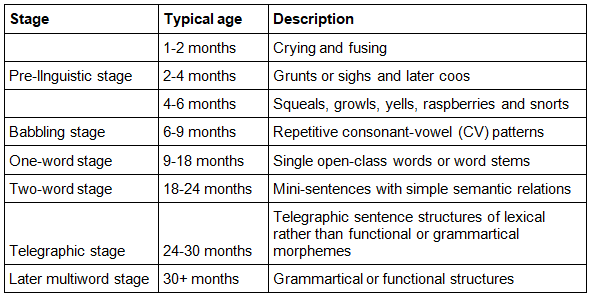Notes: Stages Of Language Development | Child Development and Pedagogy for CTET Preparation - CTET & State TET PDF Download
| Table of contents |

|
| Introduction |

|
| 1. Pre-Linguistic Stage |

|
| 2. Babbling Stage |

|
| 3. Two-Word Stage |

|
| 4. Telegraphic Stage |

|
Introduction
The stages of language development are an essential part of linguistics. Language plays a vital role in communicating with each other, across individuals and cultures. Every language has its characteristics and objectives. Now the question is, how does language develop in children?
A child acquires a language or mother tongue through different stages. After finishing all the stages, the child can achieve their mother tongue. Let us see the stages of language development. We mainly analyse the four stages of child language acquisition.
The four stages of language development in children are demonstrated in the table below:

4 Stages Of Language Development
The 4 significant stages of language development are given below:
1. Pre-Linguistic Stage
The pre-linguistic stage is the core of child language acquisition. This stage begins from birth to around seven months of age. During childbirth, the baby’s vocal tract is somewhat more like that of a chimp than that of a grown-up human. Specifically, the tip of the velum reaches or covers with the tip of the epiglottis. As the newborn child develops, the tract, bit by bit, reshapes itself in the grown-up example.
Birth to 2 Months: Infants express distress through crying. Some non-reflexive, non-trouble sounds are produced with a lowered velum and a shut or almost shut mouth, giving the impression of a syllabic nasal or a nasalised vowel.
2 to 4 Months: Between 2 to 4 months after birth, a newborn begins to produce soothing sounds. These early sounds may include snorts or moans, gradually developing into vowel-like "coos." By around three to four months, the child also starts to laugh.
4 to 7 Months: Newborn children usually participate in ‘vocal play.’ They can produce different types of sounds such as friction noises, nasal murmurs, etc.
Fun Fact: Babies start learning language in the womb, recognizing their mother’s voice.
2. Babbling Stage
The babbling stage begins around six months, when infants start using their speech organs to produce sounds. This stage involves creating syllable-like sequences by opening and closing the jaw, lips, and tongue.
Sound Production: At this stage, children rarely produce sounds like fricatives, affricates, and liquids. Initially, their vowel sounds tend to be low and open. They may also start to repeat simple syllables such as [bababa] or [nanana].
Interaction-Driven: Vocal play and Babbling are both produced when they interact with their parents or relatives. In this stage, a child randomly produces a variety of sounds, and sometimes these sounds partly match their mother tongue.
3. Two-Word Stage
The two-word stage begins when a child becomes one year or one and a half years old. In this stage, children progress from using single words to two-word combinations. At the same time, children start developing their sound production capability.
Grammatical Development: Children subconsciously apply basic grammatical rules in their speech. By the end of this stage, they may use inflexions and describe events using grammatical functions.
Examples: Phrases like "dog run" or "want milk" emerge, reflecting early sentence formation.
Fun Fact: The average toddler learns one new word every 90 minutes.
4. Telegraphic Stage
From 24 to 30 months, children enter the telegraphic stage. During this period, they begin producing expressions that contain more than two elements. These utterances are typically longer than two words and carry clear, meaningful content.
Characteristics: Only morphemes and words carrying essential semantic meaning are used, while small functional words such as “the,” “is,” “can,” and “a” are often omitted. The speech resembles telegraphic communication, focusing on core message delivery.
Examples: Phrases like “cat stand up table,” “what that,” or “no stay here” are common, showing the absence of function words but still effectively conveying meaning.
|
67 videos|154 docs|41 tests
|
FAQs on Notes: Stages Of Language Development - Child Development and Pedagogy for CTET Preparation - CTET & State TET
| 1. What are the main stages of language development in children? |  |
| 2. At what age do children typically start speaking their first words? |  |
| 3. How can parents support their child's language development? |  |
| 4. What are some signs of language delay in children? |  |
| 5. How does a child's environment influence their language development? |  |





















